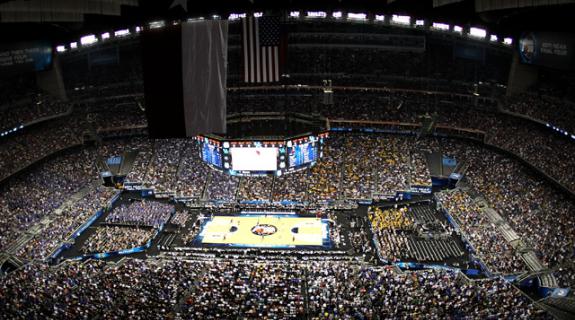“The last piece of paper that everyone walks around with in a digital world is the bracket,” says Christina Miller, Turner Sports’ senior VP and general manager of strategy, marketing and programming.
She may very well be right. In a universe where we can even give our John Hancock online through digital signatures, the March Madness bracket may be one of the last remaining bits of our cultural life that is still often carried around on old-school parchment. Which is a bit ironic, because everything else about the way people consume March Madness is completely 21st century.
This year, CBS and Turner are hoping to build off the collective success of last year’s tournament (the Final Four was the highest-rated since 2005) with some new features on mobile, digital and TV.
On a conference call earlier this week, Turner Sports President David Levy and CBS Sports Chairman Sean McManus both touted the new “Teamcast” as a new, innovative way to watch the Final Four, which is being played at AT&T Stadium in Arlington, Texas. The main semifinal broadcast will air on TBS, while TNT and truTV will air separate broadcasts focusing on one of the individual teams, complete with unique production, broadcasters and storytelling.
“We wanted to try to provide some kind of alternate viewing, give somebody a different perspective,” Levy said. “There is an expense to it obviously. There’s three different trucks, different producers, there’s directors and there’s talent.”
In a biggest-of-its-kind underground digital marketing campaign, CBS Outdoors and Turner installed 10 66-inch video screens at some of New York City’s busiest subway terminals. The video boards promote March Madness as well as streaming promos for other Turner properties including TNT and TBS shows, Adult Swim and CNN.
“Full-on immersion” is how Miller describes the March Madness push, adding that outdoor billboards and the NYC subway campaign “allows us to create a sense of urgency.”
In the mobile space, there’s no shortage of new features for the NCAA March Madness Live app. This year, the service will be made available for the first time to consumers with the Windows 8.1 and Windows Phone 8 operating systems. The app’s new bracket layout (ok, so not everyone uses a sheet of paper for their bracket) has increased functionality, allowing fans to zoom in on a certain matchup, view schedules or go right to live game coverage.
Functionality also has been improved for the March Madness Bracket Challenge, sponsored by Capital One, to allow fans to share brackets and chat with friends. The Coke Zero March Madness Social Arena will once again feature game tweets and Instagram photos, but this year also will incorporate Vine videos.
Major sponsors AT&T, Coca-Cola and Capital One are all returning to activate around this year’s March Madness Music Festival, a re-brand of the Big Dance Concert Series. This year’s three-day festival starts Friday, April 4, at Reunion Park in Dallas with country star Jason Aldean headlining the AT&T Block Party. Saturday, Tim McGraw headlines the Coke Zero Countdown followed by a live broadcast of the first Final Four game and a post-game concert by The Killers. None other than Bruce Springsteen and the E Street Band headline Sunday night, with the national championship game on Monday.
It may no longer be viewed as a watershed moment in sports television, but it’s certainly worth mentioning that this year marks the first time in the illustrious history of the NCAA men’s basketball tournament that the Final Four will air on cable. TBS can now be viewed in 99 million of America’s 114 million TV households, but the significance isn’t lost on Turner executives.
“We are keenly aware and very, very proud of the fact that the Final Four will make its first appearance ever on TBS,” says Miller. “It certainly is a big moment, but I would acknowledge some of the things that have come before it that are pretty big in their own right.”
Major sporting events on cable, or Turner for that matter, are certainly nothing new. The network has portions of the MLB and NBA playoffs on its roster as well as NASCAR and PGA tour events.
Due to its length and huge regional appeal, March Madness is huge business for the TV networks who carry it. Last year, an 30-second ad buy for the Final Four cost a reported $1.1 million, with full tournament sales netting $875 million in revenue, according to Ad Week. With earnings like that, it’s not hard to see why Turner and CBS came in with a 14-year $10.8 billion contract back in 2010 for tournament broadcast rights.
“We weren’t going to be able to compete with ESPN unless we had a partner,” said McManus earlier this week. “The only call I made was to David [Levy].” Relatively speaking, it’s still early in the partnership, but if audience numbers and metrics are an indication, for both CBS and Turner, safe to say it was a pretty good call.
Tags:













































__twocolumncontent.jpg)











